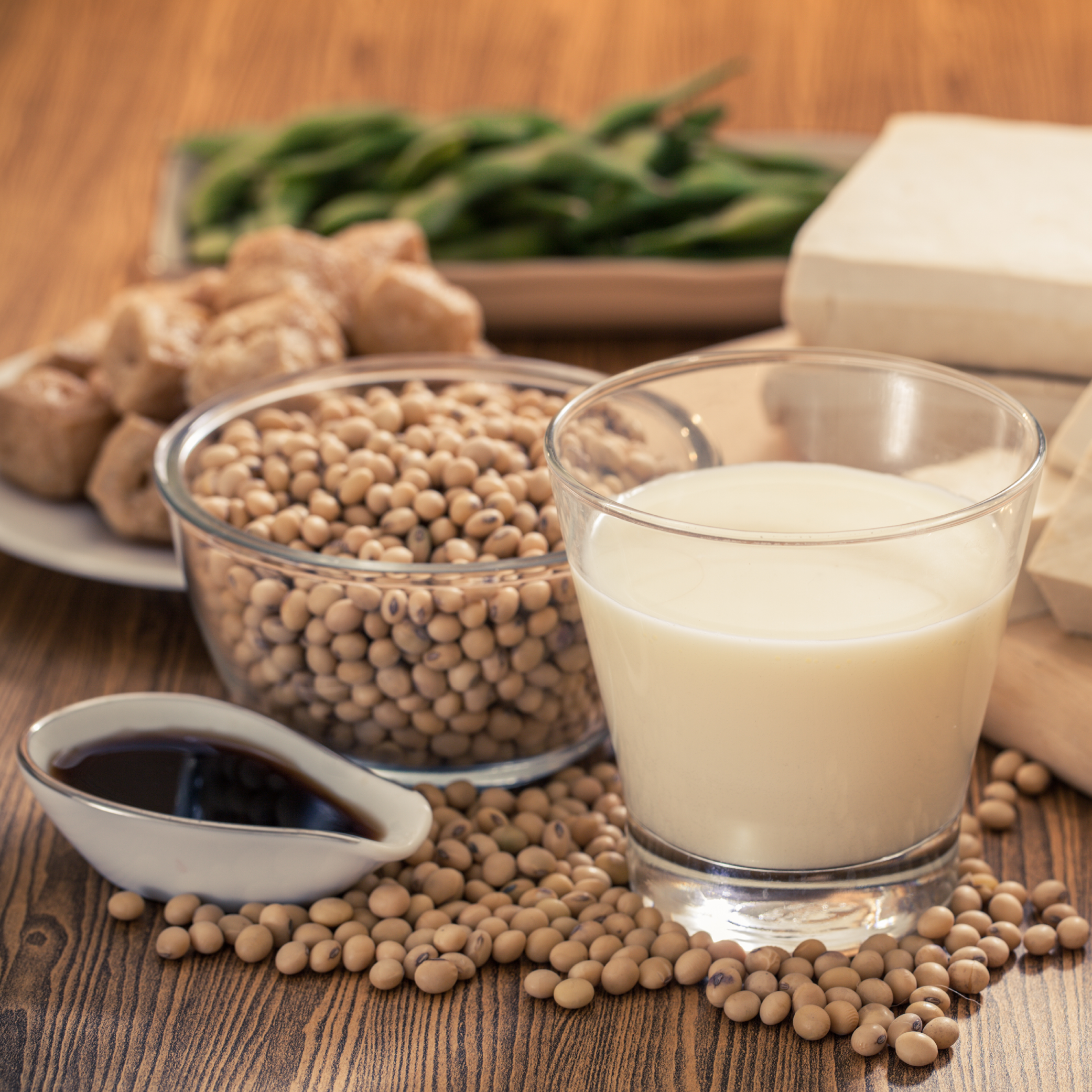THE NEED TO KNOW ABOUT SOY

Soy has been in our diets for many years and has mostly been found in Asian cuisine. As vegetarianism increases, consumption of soy has increased as well, especially in Western countries. The quality of soy protein is one of its most attractive benefits and has been used to create many soy-based vegetarian food options. This high protein content coupled with a lower carbohydrate content makes soy a unique vegetable protein. Consumption of soy can also create a sustainable alternative to meat consumption as it reduces the ecological exploitation of natural resources1.
Because soy has been around for so long, a lot of research has been done. This article will dig deeper into the storage proteins, isoflavones and saponins of the soybean. And I know those sounds like complex scientific terms, but this article will touch on what they are and help us form our own ideas around soy.
WHAT IS SOY?
Soybeans have been around and in the human diet for nearly 5 000 years. Soybeans are a good source of high-quality proteins and contain all the essential amino acids (building blocks of protein) that cannot be made naturally by the body. They also contain less saturated fat and no cholesterol when compared to animal protein sources. The composition of soybeans is dependent on where it is grown, but in general, it consists of 35-40% protein, 20% fat and 9% dietary fibre2.
Soy protein is made up of different subunits otherwise known as bioactive compounds:
- Soy consists of two main storage proteins. They are then broken down into smaller sub-units, known as amino acids and absorbed by the intestine into the blood circulation. Once they are in the blood circulation, they can be used by the body. Studies in humans demonstrated that hydrolysed (more broken down) soy protein is faster and more effectively absorbed in the body2.
- Soy isoflavones are another main compound that is found in soybeans. They are phytochemicals (phytoestrogens) and can bind to oestrogen receptors where they have both estrogenic and anti-estrogenic properties. Because of these hormonal properties as well as soy isoflavone’s antioxidant properties, they play a role in preventing osteoporosis, prostate cancer, breast cancer, heart disease, diabetes as well as menopausal symptoms2.
- Soy saponins are smaller components of the soybean. Research suggests that they contain anti-carcinogenic, hepatic (liver)-& cardio (heart) -protective, anti-inflammatory, and antimicrobial properties2.
WHY THE INTREST AROUND SOY?
Most research interest has been generated around the function of isoflavones and soy proteins in soybeans. Studies indicate that flavonoids in soybeans have elicited antioxidative effects that could potentially have a protective effect from cancer development. Bioactive soy peptides play a preventative role in hypertension, obesity, oxidative stress, hypercholesterolemia, and cancer. Several studies have shown the benefits that isoflavones can have on human health1.
There has been a rise in the concern about the adverse effect of soy consumption over the past few years. These concerns are often based on animal data and that data is difficult to extrapolate into the effects on human health. The biggest difference in the function/ effect of soybean bioactive compounds is that non-human primates and rodents have different isoflavone mechanisms of metabolism to humans1.
Role of Soy in Heart Disease, Cancer, Menopausal Symptoms, Osteoporosis
Studies have shown a link between lower risk for coronary heart disease in Asian traditional diets rich in phytoestrogens. The FDA also recommend that “25 grams of soy protein a day, as part of a diet low in saturated fat and cholesterol, may reduce the risk of heart disease”. There is some evidence on the potential benefit of these phytoestrogens in hormone-dependant cancers like breast, prostate and ovarian as well as playing a beneficial role in osteoporosis, menopausal symptoms, and the overall reduction in the risk for non-communicable diseases (like diabetes and hypertension)1.
The European Prospective Investigation into Cancer and Nutrition Study Cohort (EPIC) investigated the relationship of soy isoflavone intake and cancer risk. EPIC concluded that consuming soy isoflavones did not increase cancer risk. In general, epidemiologic studies on\ breast cancer and soy foods conclude that soy foods playa protective role1.
Reviews suggest that there may be a use for soy consumption to reduce the risk of prostate cancer, however studies do not indicate the method of soy delivery (if we should consume them as foods or supplements) that would be most effective3.
Soy and Hormones
Issues around infertility and the disruption of homeostasis of sex hormones related to soy food ingestion is in strong contrast to large populations that regularly consume soy-based products. Some studies even conclude a positive relationship between isoflavone intake and sperm count/ quality or no correlation1.
Studies done on large groups conclude that neither isoflavone nor soy intake affects total circulation testosterone concertation’s in men. Extensive clinical data was used in both and included many studies with a large number of participants4.
Evidence around fertility in humans is limited. Some studies suggest that soy intake or phytoestrogen supplements used in couples undergoing infertility treatment has been beneficial. Soy proteins can be a good alternative to reducing the consumption of red meats, which are high in saturated fatty acids, as well as seafood, which contain mercury, dioxins, and organochlorines5.
SOY PROTEIN QUALITY
One of the biggest concerns with following a vegetarian diet is obtaining the required amount of protein. Soy (as a single ingredient) is one of the only available plant proteins that has been shown to have a high quality of protein6.
Soy protein has been reported to be comparable to animal proteins and as mentioned before makes it an attractive alternative to animal proteins for vegetarians, vegans, and lactose intolerant individuals. It is a complete protein that has additional benefits such as improving lipid profiles. Soybeans are processed into three major products namely soy flour, soy concentrates and soy isolate. Soy flour is the least refined and is often found in baked goods. Soy concentrates keep most of the protein content of the bean but contain less carbohydrates when compared to soy flour. Soy concentrate is often found in cereals and bars. Soy isolate is the most refined soy protein and contains the highest concentration of protein. Soy isolate is easy to digest and is often used in sports drinks and infant formulas7.
FUTURELIFE® HIGH PROTEIN Smart food™ has been formulated with SUPRO® Soy Protein Isolate. Sourced from soybeans, the protein is ‘isolated’ from the rest of the soybean components, making it 90% protein. Containing all the essential amino acids, it is equivalent in protein quality to animal protein, contains no cholesterol and is almost fat free. SUPRO® Soy Protein Isolate is beneficially added into our unique SmartProtein3D™ blend.
Soy protein has received both negative and positive publicity over the last few years. This article highlights keys points around soy, equipping you with the knowledge to extract correct information and come to informative conclusions around soy. From the research presented above, it is evident that soy is safe to consume and can play a key role in improving our health as well as helping to create a more sustainable environment.
REFERENCES
- Messina M. Soy and Health Update: Evaluation of the Clinical and Epidemiologic Literature. Nutrients. 2016 Nov 24;8(12):754.
- Chatterjee C, Gleddie S, Xiao CW. Soybean Bioactive Peptides and Their Functional Properties. Nutrients. 2018 Sep 1;10(9):1211.
- van Die MD, Bone KM, Williams SG, Pirotta MV. Soy and soy isoflavones in prostate cancer: a systematic review and meta-analysis of randomized controlled trials. BJU Int. 2014 May;113(5b):E119-30.
- Reed KE, Camargo J, Hamilton-Reeves J, Kurzer M, Messina M. Neither soy nor isoflavone intake affects male reproductive hormones: An expanded and updated meta-analysis of clinical studies. Reprod Toxicol. 2020 Dec 28;100:60-67. doi: 10.1016/j.reprotox.2020.12.019.
- Gaskins AJ, Chavarro JE. Diet and fertility: a review. Am J Obstet Gynecol. 2018 Apr;218(4):379-389.
- Rizzo G, Baroni L. Soy, Soy Foods and Their Role in Vegetarian Diets. Nutrients. 2018 Jan 5;10(1):43.
- Hoffman JR, Falvo MJ. Protein - Which is Best? J Sports Sci Med. 2004 Sep 1;3(3):118-30.









